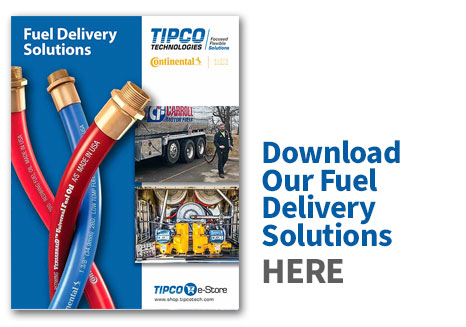
Fuel hoses are the workhorses of any fuel delivery fleet. Day in and day out, they handle flammable liquids, high pressures, rough environments, and constant movement. But even the toughest hoses have a lifespan—and waiting for one to fail can lead to serious safety risks, environmental violations, and unexpected downtime.
So how do you know when it’s time to replace a fuel hose before it becomes a liability?
Here are the top five warning signs to look for:
1. Visible Cracks, Abrasions, or Blistering
If your hose shows cracks, deep scuffs, cuts, or surface blisters, it’s time to take it out of service.
- These are often caused by UV exposure, dragging over rough surfaces, or age-related degradation.
- Even small surface damage can grow into full failures when under pressure
Quick tip: Run your hands along the hose during inspections. You might feel damage before you see it.
2. Soft Spots, Bulging, or Kinking
A healthy fuel hose should feel firm and uniform along its length. Soft spots or bulging areas often indicate internal damage or weakening of the reinforcement layer.
- Bulging = internal pressure is stressing a weak point.
- Soft spots = degradation from inside (e.g., fuel incompatibility or age).
- Repeated kinking can cause internal separation and flow restriction.
If your hose doesn’t return to its original shape after flexing or has noticeable deformations, it’s a red flag.
3. Fuel Smell or Visible Leaks
It only takes a small leak to create a big problem—especially with flammable liquids.
- Drips near fittings, wet spots on the hose jacket, or fuel odors during and after use can all point to hose failure.
- Leaks may start internally and work their way out slowly.
Note: Even a minor leak can violate DOT and EPA regulations, so it’s not worth the risk.
4. Pressure Drop or Slow Flow During Delivery
If your system is running at normal pump speed but deliveries are slower than usual, your hose might be the issue.
- Internal delamination or collapse can cause flow restrictions.
- Check for bubbling or pinched areas during operation.
This is especially common in older hoses or those used beyond their rated pressure or bend radius.
5. The Hose Is Beyond Its Rated Service Life
Most fuel hoses come with a recommended service life—often 5 to 10 years depending on usage, material, and environment.
- If your hose has no visible damage but is beyond its rated life, it’s still at risk.
- Age-related deterioration happens internally and isn’t always visible from the outside.
Pro tip: Track hose installation dates and usage hours as part of your preventive maintenance schedule.
(Extra #6) Damaged or Loose Fittings
While not technically part of the hose body, the fittings are critical to safe operation. If you notice:
- Corrosion
- Loose connections
- Damaged threads or seals
…it’s time to replace or rebuild that assembly.
Don’t Wait for Failure—Inspect, Replace, Prevent
A failed hose in a fuel delivery application can mean more than just a late delivery. It can lead to hazards, fines, environmental damage, or worse. By learning the warning signs and staying proactive with your maintenance, you’ll keep your drivers safer, your customers satisfied, and your fleet on the road.
Need help evaluating your hose assemblies or building a replacement plan? Reach out to our team—TIPCO Technologies specializes in high-performance hose solutions built for the demands of fuel delivery.



















